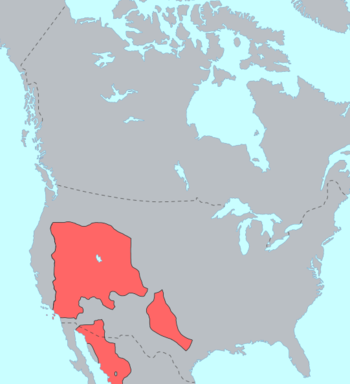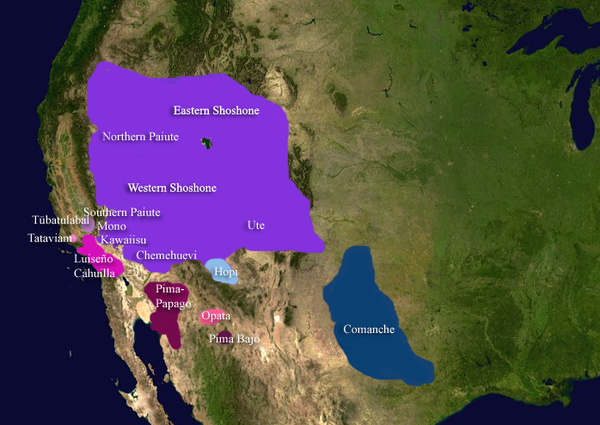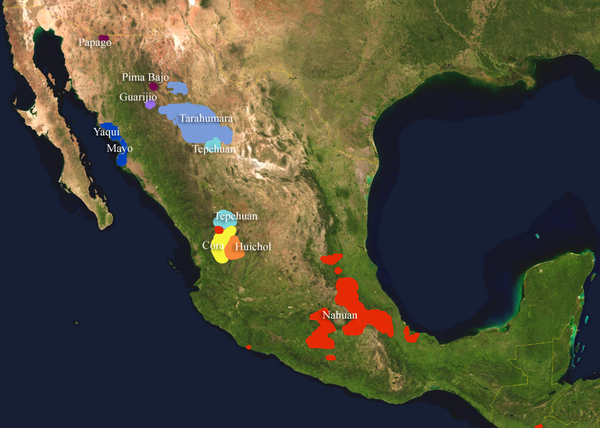- Uto-Aztecan languages
-
Uto-Aztecan Geographic
distribution:Western United States, Mexico Linguistic classification: Uto-Aztecan Proto-language: Proto-Uto-Aztecan Subdivisions: TaracahiticISO 639-5: azc 
Pre-contact distribution of Northern Uto-Aztecan languages (note: this map does not show the total distribution in Mexico).Uto-Aztecan or Uto-Aztekan /ˈjuːtoʊ.æzˈtɛkən/ is a Native American language family consisting of over 30 languages. Uto-Aztecan languages are found from the Great Basin of the Western United States (Oregon, Idaho, Montana, Utah, California, Nevada, Arizona), through western, central and southern Mexico (incl. Sonora, Chihuahua, Nayarit, Durango, Zacatecas, Jalisco, Michoacán, Guerrero, San Luis Potosí, Hidalgo, Puebla, Veracruz, Morelos, Estado de México, and the Federal District), and one dialect of Nahuatl is nearly extinct in western El Salvador and has gone extinct in Guatemala and Honduras. Utah is named after the indigenous Uto-Aztecan Ute people. Classical Nahuatl, the language of the Aztecs, and its modern relatives are part of the Uto-Aztecan family.
Contents
Proposals as to the homeland
The Uto-Aztecan homeland is generally thought to have been somewhere in the Sonoran Desert (which encompasses Arizona, New Mexico and northern Mexico).[citation needed] The homeland of the Numic branch has been placed near Death Valley, California and the origin of the putative Southern Uto-Aztecan branch is thought to have been in northwestern Mexico, in today's southern Sonora state or northern Sinaloa state.
Historic locations of living and extinct Uto-Aztecan languages in the USA and northern Mexico
Present day Locations of living Uto-Aztecan languages in Mexico and Mesoamerica
Classification of Uto-Aztecan languages
History of classification
Uto-Aztecan has been accepted by linguists as a language family since the early 1900s, and six subgroups are universally accepted as valid: Numic, Takic, Pimic, Taracahitic, Corachol, and Aztecan. This leaves two ungrouped languages—Tübatulabal and Hopi (sometimes termed "isolates within the family"). As to higher level groupings, disagreement has persisted since the 19th century. Presently there is also disagreement as to where to draw language boundaries within dialect continua.
The similarities between the Uto-Aztecan languages were noted as early as 1859 by J.C.E. Buschmann, who however failed to recognize the genetic affiliation between the Aztecan branch and the rest, instead ascribing the similarities between the two groups to diffusion. Brinton added the Aztecan languages to the family in 1891 and coined the term Uto-Aztecan. John Wesley Powell, however, rejected the claim in his own classification of North American indigenous languages (also published in 1891). Powell recognized two language families: "Shoshonean" (encompassing Takic, Numic, Hopi, and Tübatulabal) and "Sonoran" (encompassing Pimic, Taracahitan, and Corachol). In the early 1900s Alfred L. Kroeber filled in the picture of the Shoshonean group, while Edward Sapir proved the unity between Aztecan, "Sonoran", and "Shoshonean". Sapir's applications of the comparative method to unwritten Native American languages are regarded as groundbreaking.[citation needed]
As of about 2000, the most widely accepted view divides the family into "Northern Uto-Aztecan" and "Southern Uto-Aztecan". The former is Powell's "Shoshonean", while the latter is all the rest, i.e., Powell's "Sonoran" plus Aztecan. But since about 1980, there have been dissenters. They reject either both nodes or the Northern node alone.[1][2][3] Although Kaufman recognizes similarities between Corachol and Aztecan, he explains them by diffusion instead of genetic evolution.[4] Most scholars view the breakup of Proto-Uto-Aztecan as a case of the gradual disintegration of a dialect continuum.[5]
Present scheme
Below is the current most prevalent classification as synthesized from Campbell (1997), Mithun (1999), and Goddard (1999). For most of the individual languages and proposed nodes, links are provided to a selected bibliography of grammars, dictionaries, and linguistic researches. ( † = extinct)
Northern Uto-Aztecan
- Central Numic languages
- Southern Numic languages
- Western Numic languages
- Serrano–Gabrielino
- Serran
- Gabrielino–Fernandeño †
- Cupan
- Cahuilla–Cupeño
- Luiseño–Juaneño[A 26]
Southern Uto-Aztecan
Pimic (Tepiman)
- Pima–Papago[A 27] (Upper Piman)
- Pima Bajo[A 28] (Lower Piman)
- Tepehuán languages (Northern[A 29] and Southern[A 30])
- Tepecano[A 31] †
Taracahitic
- Tarahumaran
- Tarahumara[A 32]
- Guarijío[A 33] (Varihio)
- Tubar[A 34] †
- Cahita[A 35] (Yaqui[A 36]–Mayo[A 37]–Cahita)
- Opatan
Corachol
Aztecan
In addition to the above languages for which linguistic evidence exists, there were several dozen extinct languages with little or no documentation in Northern Mexico, many of which were probably Uto-Aztecan.[6]
The proto–Uto-Aztecan language
Vowels
Proto-Uto-Aztecan is reconstructed as having an unusual five-vowel system: *i *a *u *o *ɨ. Langacker (1970) demonstrated that the fifth vowel should be reconstructed as *ɨ as opposed to *e—there had been a long-running dispute over the proper reconstruction.[7]
Consonants
Bilabial Coronal Palatal Velar Labialized
velarGlottal Stop *p *t *k *kʷ *ʔ Affricate *t͡s Fricative *s *h Nasal *m *n *ŋ Rhotic *r Semivowel *j *w *n and *ŋ may have actually been *l and *n, respectively.
Notes
- ^ Goddard 1996, p. 7.
- ^ Miller 1983, p. 118.
- ^ Mithun 1999, p. 539-540.
- ^ Kaufman 2001.
- ^ Mithun 1999.
- ^ Campbell 1997.
- ^ Campbell 1997, p. 136.
Bibliography
- Campbell, Lyle (1997). American Indian Languages: The Historical Linguistics of Native America. Oxford Universiity Press.
- Goddard, Ives (1996) "Introduction" in Goddard, Ives Handbook of North American Indians 17 Washington, D.C.: Smithsonian Institution pp. 1–16
- Kaufman, Terrence (2001) Nawa linguistic prehistory Mesoamerican Language Documentation Project http://www.albany.edu/anthro/maldp/papers.htm
- Miller, Wick R. (1983) "Uto-Aztecan languages" in Ortiz, Alfonso Handbook of North American Indians 10 Washington, D.C.: Smithsonian Institution pp. 113–124
- Mithun, Marianne (1999). The languages of Native America. Cambridge University Press.
Further reading
- Campbell, Lyle (1979). "Middle American languages". In Campbell, Lyle; Mithun, Marianne. The Languages of Native America: Historical and Comparative Assessment. Austin: University of Texas Press. pp. 902–1000.
- Goddard, Ives (1999). Native languages and language families of North America (wall map). Lincoln, Nebraska: University of Nebraska Press.
- Steele, Susan. "Uto-Aztecan: An assessment for historical and comparative linguistics". In Campbell, Lyle; Mithun, Marianne.. The Languages of Native America: Historical and Comparative Assessment.. Austin: University of Texas Press. pp. 444–544.
- Suárez, Jorge (1983). The Mesoamerican Indian languages. Cambridge University Press.
Grammars or linguistic researches for individual languages and Uto-Aztecan groupings
- ^ Whorf, Benjamin Lee. 1946. The Hopi Language, Toreva Dialect. In Cornelius Osgood, ed., Linguistic structures of native America. New York: Wenner-Gren Foundation pp. 902-1000. Viking Fund Publications in Anthropology; 6.
Hopi Dictionary Project (1998). Hopi Dictionary: Hopìikwa Lavàytutuveni: A Hopi–English Dictionary of the Third Mesa Dialect With an English–Hopi Finder List and a Sketch of Hopi Grammar. Tucson: University of Arizona Press.- Jeanne, LaVerne Masayesva (1978). Aspects of Hopi grammar. MIT, dissertation.
- ^ C.F. Voegelin. 1935. Tübatulabal Grammar. University of California Publications in American Archaeology and Ethnology 34/2. Berkeley: University of California Press.
C.F. Voegelin. 1958. "Working Dictionary of Tubatulabal," International Journal of American Linguistics 24:221–228. - ^ David Iannucci. 1972. "Numic historical phonology," Cornell University PhD dissertation.
Michael Nichols. 1973. "Northern Paiute historical grammar," University of California, Berkeley PhD dissertation
Wick R. Miller. 1986. "Numic Languages," Handbook of North American Indians, Volume 11, Great Basin. Ed. by Warren L. d’Azevedo. Washington: Smithsonian Institution. Pages 98–106. - ^ Lila Wistrand Robinson & James Armagost. 1990. Comanche Dictionary and Grammar. Summer Institute of Linguistics and The University of Texas at Arlington Publications in Linguistics Publication 92. Dallas, Texas: The Summer Institute of Linguistics and The University of Texas at Arlington.
Jean O. Charney. 1993. A Grammar of Comanche. Studies in the Anthropology of North American Indians. Lincoln, Nebraska: University of Nebraska Press. - ^ Jon P. Dayley. 1989. Tümpisa (Panamint) Shoshone Grammar. University of California Publications in Linguistics Volume 115. Berkeley, California: University of California Press.
Jon P. Dayley. 1989. Tümpisa (Panamint) Shoshone Dictionary. University of California Publications in Linguistics Volume 116. Berkeley, California: University of California Press. - ^ John E. McLaughlin. 2006. Timbisha (Panamint). Languages of the World/Materials 453. Muenchen: LINCOM Europa.
- ^ Richley H. Crapo. 1976. Big Smokey Valley Shoshoni. Desert Research Institute Publications in the Social Sciences 10. Reno: University of Nevada Press.
Beverly Crum & Jon Dayley. 1993. Western Shoshoni Grammar. Boise State University Occasional Papers and Monographs in Cultural Anthropology and Linguistics Volume No. 1. Boise, Idaho: Department of Anthropology, Boise State University. - ^ Wick R. Miller. 1972. Newe Natekwinappeh: Shoshoni Stories and Dictionary. University of Utah Anthropological Papers 94. Salt Lake City: University of Utah Press.
Wick R. Miller. 1996. "Sketch of Shoshone, a Uto-Aztecan Language," Handbook of North American Indians, Volume 17, Languages. Ed. Ives Goddard. Washington, D.C.: Smithsonian Institution. Pages 693–720. - ^ Drusilla Gould & Christopher Loether. 2002. An Introduction to the Shoshoni Language: Dammen Daigwape. Salt Lake City, Utah: The University of Utah Press.
- ^ D.B. Shimkin. 1949. "Shoshone, I: Linguistic Sketch and Text," International Journal of American Linguistics 15:175–188.
D. B. Shimkin. 1949. "Shoshone II: Morpheme List," International Journal of American Linguistics 15.203–212.
Malinda Tidzump. 1970. Shoshone Thesaurus. Grand Forks, North Dakota. - ^ Maurice L. Zigmond, Curtis G. Booth, & Pamela Munro. 1991. Kawaiisu, A Grammar and Dictionary with Texts. Ed. Pamela Munro. University of California Publications in Linguistics Volume 119. Berkeley, California: University of California Press.
- ^ Margaret L. Press. 1979. Chemehuevi, A Grammar and Lexicon. University of California Publications in Linguistics Volume 92. Berkeley, California. University of California Press.
Laird, Carobeth. 1976. The Chemehuevis. Malki Museum Press, Banning, California. - ^ Edward Sapir. 1930. Southern Paiute, a Shoshonean Language. Reprinted in 1992 in: The Collected Works of Edward Sapir, X, Southern Paiute and Ute Linguistics and Ethnography. Ed. William Bright. Berlin: Mouton deGruyter.
Edward Sapir. 1931. Southern Paiute Dictionary. Reprinted in 1992 in: The Collected Works of Edward Sapir, X, Southern Paiute and Ute Linguistics and Ethnography. Ed. William Bright. Berlin: Mouton deGruyter.
Pamela A. Bunte. 1979. "Problems in Southern Paiute Syntax and Semantics," Indiana University Ph.D. dissertation. - ^ Talmy Givón. 2011. Ute Reference Grammar. Culture and Language Use Volume 3. Amsterdam: John Benjamins Publishing Company.
Jean O. Charney. 1996. A Dictionary of the Southern Ute Language. Ignacio, Colorado: Ute Press. - ^ Sidney M. Lamb. 1957. "Mono Grammar," University of California, Berkeley Ph.D. dissertation.
Rosalie Bethel, Paul V. Kroskrity, Christopher Loether, & Gregory A. Reinhardt. 1993. A Dictionary of Western Mono. 2nd edition. - ^ Evan J. Norris. 1986. "A Grammar Sketch and Comparative Study of Eastern Mono," University of California, San Diego Ph.D. dissertation.
- ^ Anonymous. 1987. Yerington Paiute Grammar. Anchorage, Alaska: Bilingual Education Services.
Arie Poldevaart. 1987. Paiute–English English–Paiute Dictionary. Yerington, Nevada: Yerington Paiute Tribe. - ^ Allen Snapp, John Anderson, & Joy Anderson. 1982. "Northern Paiute," Studies in Uto-Aztecan Grammar, Volume 3, Uto-Aztecan Grammatical Sketches. Ed. Ronald W. Langacker. Summer Institute of Linguistics Publications in Linguistics Publication Number 57, Volume III. Dallas, Texas: Summer Institute of Linguistics and The University of Texas at Arlington. Pages 1–92.
- ^ Timothy John Thornes. 2003. "A Northern Paiute Grammar with Texts," University of Oregon Ph.D. dissertation.
- ^ Sven Liljeblad. 1966–1967. "Northern Paiute Lessons," manuscript.
Sven Liljeblad. 1950. "Bannack I: Phonemes," International Journal of American Linguistics 16:126–131 - ^ In addition to the Takic languages considered by Campbell, Tataviam has been recognized as a separate Takic language (Goddard 1996:7; Mithun 1999:539). Tataviam has sometimes been called by a Chumash name, Alliklik, although other scholars have reserved that name for a Chumash dialect or language (cf. Campbell 1997:135; Mithun 1999:544)
- ^ Kenneth C. Hill. 1967. A Grammar of the Serrano Language, University of California, Los Angeles, PhD dissertation.
- ^ Alice J. Anderton. 1988. The Language of the Kitanemuks of California, University of California, Los Angeles, PhD dissertation.
- ^ Hansjakob Seiler. 1977. Cahuilla Grammar. Banning, California: Malki Museum Press.
Hansjakob Seiler and Kojiro Hioki. 1979. Cahuilla Dictionary. Banning, California: Malki Museum Press. - ^ Jane H. Hill & Rosinda Nolasquez. 1973. Mulu'wetam, the First People: Cupeno Oral History and Language. Banning, California: Malki Museum Press.
Jane H. Hill. 2005. A Grammar of Cupeño. University of California Publications in Linguistics. Berkeley: University of California Press. - ^ Most authorities have agreed with Campbell in considering Juaneño (now extinct) a dialect of Luiseño, but Mithun (1999:539) classified it as a separate language.
Alfred L. Kroeber & George William Grace. 1960. The Sparkman Grammar of Luiseño. University of California Publications in Linguistics 16. Berkeley: The University of California Press.
William Bright. 1968. A Luiseno Dictionary. University of California Publications in Linguistics 51. Berkeley: University of California Press.
Villiana Hyde. 1971. An Introduction to the Luiseño Language. Banning, California: Malki Museum Press.
Eric Bryant Elliott. 1999. "Dictionary of Rincon Luiseno," University of California, San Diego PhD dissertation. - ^ Ofelia Zepeda. 1983 . A Tohono O'odham Grammar. Tucson, Arizona: The University of Arizona Press.
Dean Saxton, Lucile Saxton, & Susie Enos. 1998. Dictionary: Tohono O'Odham/Pima to English, English to Tohono O'Odham/Pima. 2nd edition. Tucson, Arizona: University of Arizona Press. - ^ Roberto Escalante H. & Zarina Estrada Fernandez. 1993. Textos y gramatica del pima bajo. Sonora: Departamento de Letra y Linguistica, Universidad de Mexico.
- ^ Burton W. Bascom. 1982. "Northern Tepehuan," Studies in Uto-Aztecan Grammar, Volume 3, Uto-Aztecan Grammatical Sketches. Ed. by Ronald W. Langacker. Dallas: Summer Institute of Linguistics and the University of Texas at Arlington. Pages 267–393.
- ^ T. Willett. 1991. A reference grammar of southeastern Tepehuan. Dallas: Summer Institute of Linguistics and University of Texas at Arlington.
- ^ J. Alden Mason. 1916. "Tepecano, A Piman language of western Mexico," Annals of the New York Academy of Science 25:309–416.
- ^ Donald H. Burgess. 1984. "Western Tarahumara," Studies in Uto-Aztecan grammar 4: Southern Uto-Aztecan grammatical sketches. Ed. Ronald W. Langacker. Summer Institute of Linguistics Publications in Linguistics 56. Dallas: Summer Institute of Linguistics and the University of Texas at Arlington. Pages 1–149.
- ^ Wick R. Miller. 1996. La lengua guarijio: gramatica, vocabulario y textos. Mexico City: Instituto de Investigaciones Antropologicas, UNAM.
- ^ Andrés Lionnet. 1978. El idioma tubar y los tubares. Segun documentos ineditos de C. S. Lumholtz y C. V. Hartman. Mexico, D. F: Universidad Iberoamericana.
- ^ Andrés Lionnet. 1978. Elementos de la lengua cahita (yaqui–mayo). México: Universidad Nacional Autónoma de México.
- ^ John M. Dedrick & Eugene H. Casad, ed. 1999. Yaqui Language Structures. Tucson: University of Arizona Press.
David L. Shaul. 1999. Yoeme–English English–Yoeme Standard Dictionary. New York: Hippocrene Books. - ^ Howard Collard & E. Collard. 1962. Vocabulario Mayo. Vocabularios Indígenas No. 6. México: ILV.
Jeff Burnham. 1984. Una gramática de la Lengua Mayo. Hermosillo, Sonora: Universidad de Sonora. - ^ Natal Lombardo. 1702. Arte de la Lengua Teguima vulgarmente llamada Opata. Mexico: Miguel de Ribera.
- ^ Andrés Lionnet. 1986. El eudeve, un idioma extinto de Sonora (Study based on materials of J. Johnson, Loaysa, Bartlett, and Smith). Mexico: Instituto de Investigaciones Antropologicas, Universidad Nacional Autonoma de Mexico.
David L. Shaul. 1991. "Eudeve morphosyntax: an overview," International Journal of American Linguistics 57:70–107. - ^ Eugene H. Casad. 1984. "Cora," Studies in Uto-Aztecan grammar 4: Southern Uto-Aztecan grammatical sketches. Ed. Ronald W. Langacker. Summer Institute of Linguistics Publications in Linguistics 56. Dallas: Summer Institute of Linguistics and the University of Texas at Arlington. Pages 153–149.
- ^ José Luis Iturrioz Leza y Julio Ramírez de la Cruz, et al. 2001. Gramática Didáctica del Huichol: Vol. I. Estructura Fonológica y Sistema de Escritura. Departamento de Estudios en Lenguas Indígenas–Universidad de Guadalajara – Secretaria de Educación Pública.
- ^ Franz Boas. 1917. "El dialecto mexicano de Pochutla, Oaxaca," International Journal of American Linguistics 1:9–44.
- ^ Yolanda Lastra de Suárez. 1986. Las áreas dialectales del náhuatl moderno. Mexico: Instituto de Investigaciones Antropológicas, Universidad Nacional Autónoma de México.
- ^ Lyle Campbell. 1985. The Pipil language of El Salvador. Berlin: Mouton. Mouton grammar library; 1.
- ^ Fray Alonso de Molina. 1992 [1555]. Vocabulario en Lengua Castellana y Mexicana y Mexicana y Castellana. Mexico, D.F.: Porrúa.
- ^ Horacio Carochi. 1983 [1645]. Arte de la lengua mexicana: con la declaración de los adverbios della. Mexico, D.F.: Porrúa.
External links
- Uto-Aztecan.org, a website devoted to the comparative study of the Uto-Aztecan language family
- Swadesh vocabulary lists for Uto-Aztecan languages (from Wiktionary's Swadesh-list appendix)
- Ethnologue: Uto-Aztecan
- LINGUIST List MultiTree Project: Uto-Aztecan
 Indigenous peoples of the Americas
Indigenous peoples of the AmericasHistory 
European
colonizationBy country North AmericaGreenland · Canada · United States · Jamaica · Mexico · Central America · El Salvador · West Indies · PanamaSouth AmericaRelated topics Indigenous American studies · Indigenous languages · Indigenous Movements · Indigenous art · Artists · WritersCategories:- Agglutinative languages
- Uto-Aztecan languages
- Indigenous languages of California
- Indigenous languages of Mexico
- Indigenous languages of the North American Southwest
- Indigenous languages of the North American Great Basin
- Indigenous languages of the Southwestern United States
- Languages of the United States
Wikimedia Foundation. 2010.


